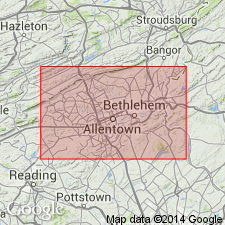
- Usage in publication:
-
- Allentown limestone
- Modifications:
-
- Original reference
- Dominant lithology:
-
- Limestone
- AAPG geologic province:
-
- Appalachian basin
Summary:
Pg. 416. Allentown limestone. White to gray, dolomitic limestone, largely oolitic; 2,000 feet thick. Full of cryptozoan. Underlies Coplay limestone and overlies Leithsville formation. Assigned to Upper Cambrian.
[Named from exposures along Lehigh and Jordan Creeks in vicinity of Allentown, Lehigh Valley district, eastern PA.]
[GNC remark (ca. 1936, US geologic names lexicon, USGS Bull. 896, p. 35): Is a part of Conochocheague limestone.]
Source: US geologic names lexicon (USGS Bull. 896, p. 35).
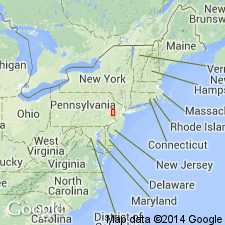
- Usage in publication:
-
- Allentown Dolomite*
- Modifications:
-
- Overview
- AAPG geologic province:
-
- Appalachian basin
Summary:
The Allentown Dolomite in eastern PA and western NJ consists of light-medium gray or light-olive gray to dark-medium gray, fine- to medium-grained rock that weathers light and dark gray in alternating beds. Bedding thickness alternates rhythmically from poorly laminated, massive beds averaging 3 ft in thickness, to platy or shaly beds less than an inch in thickness. Unit contains beds of oolite, orthoquartzite, dolarenite, and desiccation dolorudite. Lithologies occur in cycles from 5 to 30 ft thick. Thickness is about 1,700 ft. Overlies Leithsville Formation and underlies Rickenbach Dolomite; both lower and upper contacts are transitional. The Allentown is of Cambrian age.
Source: GNU records (USGS DDS-6; Reston GNULEX).
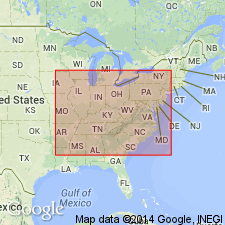
- Usage in publication:
-
- Allentown Member
- Modifications:
-
- Revised
- AAPG geologic province:
-
- Appalachian basin
Summary:
Revised the Allentown as the Allentown Member of the Kittatinny Formation in northwestern NJ. Consists of rhythmically bedded, light to dark gray, fine- to medium-grained, crystalline, impure dolomite that weathers light gray to dark gray. Lower part is alternating light to dark thin bedded dolomite with shaly bands; upper part is thicker bedded. Thickness is about 1,300 ft. Overlies Leithsville Member and underlies Rickenbach Member, both of the Kittatinny.
Source: GNU records (USGS DDS-6; Reston GNULEX).
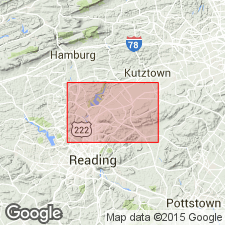
- Usage in publication:
-
- Allentown Formation
- Modifications:
-
- Revised
- AAPG geologic province:
-
- Appalachian basin
Summary:
The Allentown Formation is divided into (ascending) Tuckerton, Muhlenberg, and Maiden Creek Members. The Tuckerton consists of 500 to 650 ft of predominantly medium-gray and light- to medium-dark-gray, magnesian to calcareous limestone and dolomite; the Muhlenberg consists of 800 ft of medium- to medium-light-gray, thick-bedded magnesian limestone and dolomite; the Maiden Creek consists of 1,230 feet of medium- to medium-dark-gray, thick-bedded dolomite and magnesian limestone. The Allentown is approximately 2,600 ft thick. Overlies Leithsville Formation and underlies the Stonehenge Formation of the Beekmantown Group.
Source: GNU records (USGS DDS-6; Reston GNULEX).
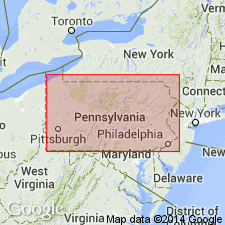
- Usage in publication:
-
- Allentown Formation
- Modifications:
-
- Overview
- AAPG geologic province:
-
- Appalachian basin
Summary:
The Allentown Formation in the Lehigh Valley sequence of PA consists of medium- to medium-dark-gray, thick-bedded dolomite and impure limestone with dark-gray chert stringers and nodules, and laminated, oolitic, and stromatolitic beds. Also contains some orange-brown-weathering calcareous siltstone at base. Overlies the Leithsville Formation.
Source: GNU records (USGS DDS-6; Reston GNULEX).
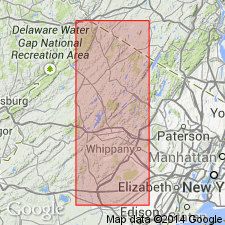
- Usage in publication:
-
- Allentown Dolomite*
- Modifications:
-
- Revised
- AAPG geologic province:
-
- Appalachian basin
Summary:
Revised the Allentown Dolomite as part of the Kittatinny Supergroup in the Lehigh Valley of eastern PA and NJ. Age is changed to Late Cambrian and earliest Ordovician. Consists of very fine- to medium-grained, light-gray to medium-dark gray, alternating light- and dark-gray weathering, rhythmically bedded dolomite containing abundant algal stromatolites, oolite beds, and scattered beds and lenses of orthoquartzite. Overlies Leithsville Formation and underlies Stonehenge Limestone of Beekmantown Group; upper and lower contacts gradational. Thickness is about 575 m.
Source: GNU records (USGS DDS-6; Reston GNULEX).
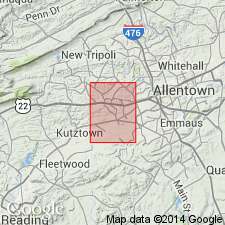
- Usage in publication:
-
- Allentown Dolomite*
- Modifications:
-
- Overview
- AAPG geologic province:
-
- Appalachian basin
Summary:
Three members comprising the Allentown Dolomite adopted for use in southeast Lehigh and Berks Cos., PA: Tuckerton Member (base), Muhlenberg Member, and Maiden Creek Member.
Source: GNU records (USGS DDS-6; Reston GNULEX).
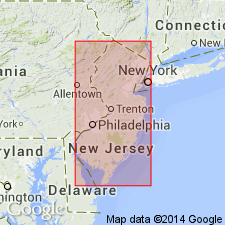
- Usage in publication:
-
- Allentown Formation
- Modifications:
-
- Overview
- AAPG geologic province:
-
- Appalachian basin
Summary:
In NJ, two mappable units are present within the Allentown. Name Limeport Member assigned to lower part by Markewicz and Dalton (1977). Upper member referred to simply as Upper Allentown pending further work. The Limeport consists of finely- to medium-crystalline, thin to thick, cyclically bedded, light- to dark-gray dolomite. Oolites, cryptozoa, ripple marks, mud cracks, cross-bedding and chip conglomerates predominate. Many algal structures present. Limeport varies in thickness form 400 to 700 ft throughout most of the state. Upper member is equivalent to the Allentown as defined by Howell and others (1950). In the Hamburg area member thickness reaches 1200 ft while near Columbia, it thins to less than 500 ft. This unit is more massive and thick-bedded than the Limeport. Varies from a fine to medium crystalline, light to dark gray dolomite. Stromatolite and oolite beds are rare. Allentown overlies the Leithsville Formation and underlies the Rickenbach Formation. Allentown is Late Cambrian.
Source: GNU records (USGS DDS-6; Reston GNULEX).
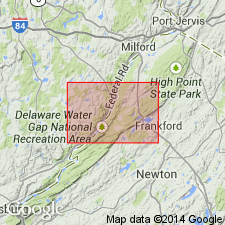
- Usage in publication:
-
- Allentown Dolomite
- Modifications:
-
- Overview
- AAPG geologic province:
-
- Appalachian basin
Summary:
Allentown Dolomite of Kittatinny Supergroup is oldest unit mapped in this area. Crops out only in the southeast corner of the map. Thickness estimated at 1,900 ft. Underlies Lower Ordovician Beekmantown Group. Age is Late Cambrian and earliest Ordovician.
Source: GNU records (USGS DDS-6; Reston GNULEX).
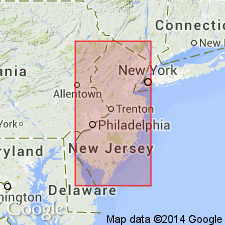
- Usage in publication:
-
- Allentown Dolomite*
- Modifications:
-
- Age modified
- AAPG geologic province:
-
- Appalachian basin
Summary:
Age of Allentown Dolomite changed to Late Cambrian and Early Ordovician(?) because of the uncertainty in placement of the Cambrian-Ordovician boundary.
Source: GNU records (USGS DDS-6; Reston GNULEX).
For more information, please contact Nancy Stamm, Geologic Names Committee Secretary.
Asterisk (*) indicates published by U.S. Geological Survey authors.
"No current usage" (†) implies that a name has been abandoned or has fallen into disuse. Former usage and, if known, replacement name given in parentheses ( ).
Slash (/) indicates name conflicts with nomenclatural guidelines (CSN, 1933; ACSN, 1961, 1970; NACSN, 1983, 2005, 2021). May be explained within brackets ([ ]).

